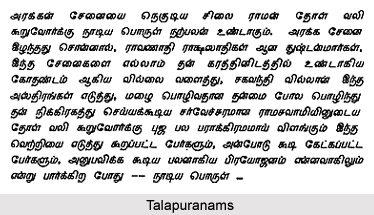 Talapuranams in Tamil literature were utilised as a mechanism to narrate various tales that were adapted out from real situations in life. The Tamil Talapuranams generally lacked realism and the authors instead of depicting the life of people in their natural surroundings, indulged in artistic and creative descriptions, including gratuitous jugglery of words. This was done to create an interest of literary arts among the general readers. After the composition of Koyilpuranam by Umapaticivam, numerous puranams were created on essential temples in the Tamil country. The most famous Talapuranams amongst them are the ones that describe the sixty four miracles of Lord Shiva, the presiding deity of Madurai. Poets such as Parancoti, Perum Parrappuliyur Nampi and Vempatturar composed Puranams elaborately mentioning about the miracles of Shiva.
Talapuranams in Tamil literature were utilised as a mechanism to narrate various tales that were adapted out from real situations in life. The Tamil Talapuranams generally lacked realism and the authors instead of depicting the life of people in their natural surroundings, indulged in artistic and creative descriptions, including gratuitous jugglery of words. This was done to create an interest of literary arts among the general readers. After the composition of Koyilpuranam by Umapaticivam, numerous puranams were created on essential temples in the Tamil country. The most famous Talapuranams amongst them are the ones that describe the sixty four miracles of Lord Shiva, the presiding deity of Madurai. Poets such as Parancoti, Perum Parrappuliyur Nampi and Vempatturar composed Puranams elaborately mentioning about the miracles of Shiva.
The most well known Talapuranam was written by Parancoti in viruttam metre containing three thousand three hundred and sixty melodic verses. The literary work has become most popular due to its manner of composition, lucidity, presentation and vivid narration of natural scenery. Many poets from the Dharmapuram Muth wrote puranams in praise of the deities at Tiruvorriyur and Tirumalapati temples. Both Cetupuranam and Tirupparahkirippuranam and were composed by Nirampa Alakia Tecikar. Citamparapuranam by Thiru Malainatar and Tanikaippurdnam by Munivar praise the deities at Chidambaram and Tiruttani shrines respectively. Tanikaippuranam is also one of the renowned puranams in Tamil. There also many Talapuranams composed for the shrines at Kumbakonam, Vedaranyam, Viringipuram, Tiruchchengodu, Tiruvannamalai, Tiruvengadu and Tiruvarur. Tirukkuvappuranam was composed by the famous Tamil poet Civappirakacar. He also composed the very fascinating Cikalattippuranam, along with his brother. Tirukkalukkunrappuranam was composed by another poet named Virarakava Mudaliar.
The Talapuranams had enthralled the readers and the general Tamil population by this period. The vision of the poets about nature, landscape, fertility of the soil and the life of the common people are incorporated in the Talapuranams along with profuse elaboration of the region and the city. Some Talapuranams also depicted about the powerful and wicked people who after experiencing miseries in life, turn to temples for consolation and ultimately emerge as noble people.
During the 17th century, Tamil poet Ellappa Navalar gained popularity by composing Talapuranams for the shrines at Tiruchchengattangudi, Tirthagiri, Tiruvirinjai, Tiruvengadu and Tiruvannamalai. Ellappa Navalar was a very capable poet who illustrated captivatingly elaborate natural scenery through his words. The Talapuranams written by him comprised of several captivating and devotional hymns. Navalar composed the Tiruvarunaikkalampakam, considered as one of the best Kalampakams, eulogizing the presiding deity at Tiruvannamalai. The work consists of several verses of high literary value. Moreover poets like Nanakkuttar and Nanappirakacar wrote Talapuranams for shrines at Thiruvarur and Tiruvorriyur respectively. Many Talapuranams were composed for the shrines in the Tamil land as well.
The Talapuranams generally describe those celestials such as Intiran and others, who are venerated at the shrines in order to amplify the sanctity and importance of the shrines and to forgive themselves from their curses and sins. Further more, the Talapuranams provide a vivid description of the landscape, including the rivers and the mountains. Little variation is observed in most of the puranams, either in plot or in the description.













